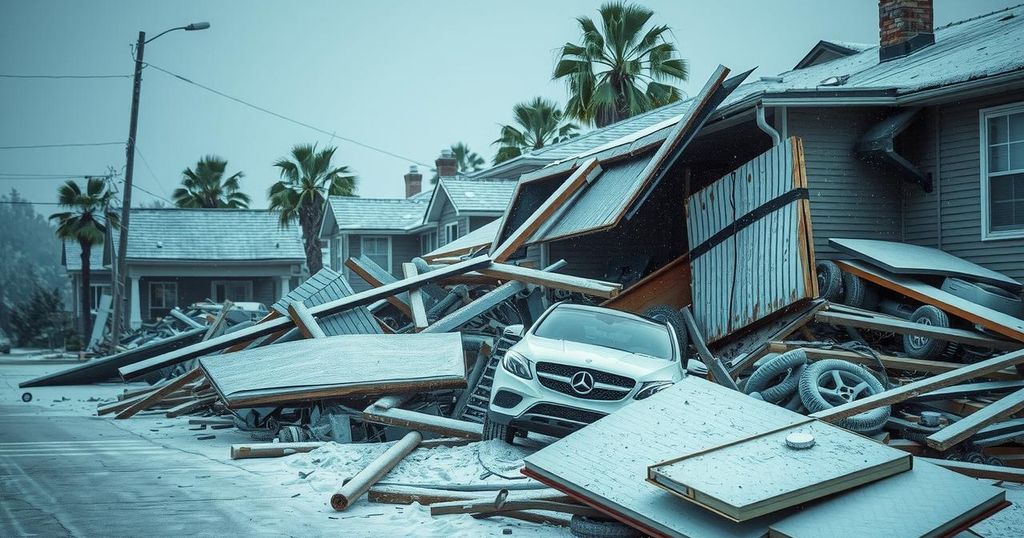Hurricane Helene was a Category 4 storm that struck the Southeast in September, causing monumental flooding and claiming 241 lives across five states: Florida, Georgia, South Carolina, North Carolina, and Tennessee. The storm initiated widespread destruction in rural communities, decimating homes, infrastructure, and agricultural resources, leaving enduring impacts that prompted significant recovery efforts.
Hurricane Helene emerged as one of the most catastrophic storms in recent United States history, impacting the Southeast with devastating effects. In September, the storm traversed five states: Florida, Georgia, South Carolina, North Carolina, and Tennessee, leaving behind a trail of destruction characterized by extensive flooding and significant loss of life, with at least 241 fatalities reported. The ensuing damage was both profound and multifaceted, including devastated communities and infrastructure in the storm’s wake.
As Helene formed in the Gulf of Mexico, areas such as western North Carolina were already experiencing heavy rainfall. Local naturalist Tal Galton anticipated severe flooding in the South Toe River Valley, a region historically prone to floods. His concerns were not unwarranted, as Helene’s torrential rains ultimately exceeded previous records in the area.
When Helene made landfall in Florida as a Category 4 hurricane, it unleashed destructive winds and storm surges, particularly in sparsely populated rural regions. Communities in Pinellas County experienced major flooding, resulting in at least twelve confirmed deaths. Over the next day, the hurricane continued its course, wreaking havoc across Georgia, where residents faced high winds and widespread power outages. The storm left at least 33 people dead across the state, with significant losses reported in agriculture and property.
South Carolina endured extreme weather conditions as well, with Helene spawning 21 tornadoes and causing extensive power outages affecting over 1.4 million customers. Tragically, 49 fatalities were reported in the state, and significant damage was inflicted on agricultural infrastructure. North Carolina experienced unprecedented flooding, particularly in the Yancey County area, where rivers exceeded historical high-water marks, resulting in numerous fatalities, including those of recent refugees.
In Tennessee, Helene’s rains further exacerbated already saturated grounds, leading to record-breaking flooding and resulting in 17 deaths, including a tragic incident involving workers at a local plant. As communities grapple with the aftermath, the urgent need for recovery assistance from both state and federal sources becomes increasingly clear.
In summary, Hurricane Helene’s impact was devastating, marking a significant natural disaster that would reverberate through five states as residents face the long road to recovery. The storm claimed lives, obliterated homes, and left lasting scars on local economies and infrastructures across the Southeast, underscoring the ongoing challenges posed by extreme weather events that scientists attribute to climate change.
Helene’s legacy is not merely one of destruction but also of resilience as affected communities seek to rebuild and recover from the profound losses suffered during this unprecedented tropical storm.
Hurricane Helene formed in the Gulf of Mexico and rapidly intensified, resulting in severe flooding and destruction as it made landfall in Florida and moved through several southeastern states. The region had already been susceptible to heavy rains prior to the storm’s arrival, leading to significant concern among local residents and officials regarding historical flooding patterns. Reports from multiple states reveal the scale and severity of the damage, highlighting the human and economic costs associated with natural disasters of this magnitude. Helene stands out as a reminder of the potential devastation that can arise from hurricanes, particularly in the context of increased climate variability.
In conclusion, Hurricane Helene emerged as one of the deadliest storms in the recent history of the United States, prosecuting widespread destruction across the Southeast. The storm not only resulted in substantial loss of life but also inflicted severe damage to infrastructure and local economies, sparking ongoing recovery efforts. As communities begin the arduous process of rebuilding, the lessons learned from this tragic event may prompt further discussions on disaster preparedness and climate resilience in the face of future weather-related challenges.
Original Source: www.usatoday.com






